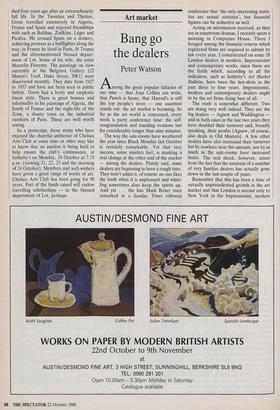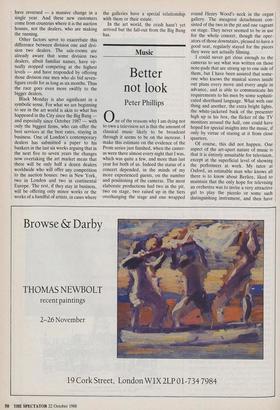Art market
Bang g©
the dealers
Peter Watson
Among the great popular fallacies of our time — that Joan Collins can write, that Punch is funny, that Harrod's is still the top people's store — one assertion stands out: the art market is booming. So far as the art world is concerned, every week is party conference time: the self- congratulation and standing ovations last for considerably longer than nine minutes.
The way the sale-rooms have weathered the year since Black Monday last October is certainly remarkable. Yet that very success, some insiders feel, is masking a real change at the other end of the market — among the dealers. Plainly said, some dealers are beginning to have a rough time. They won't admit it, of course: no one likes the truth when it is unpleasant and whist- ling sometimes does keep the spirits up. And yet . . . the late Mark Boxer once remarked at a Sunday Times editorial conference that 'the only interesting statis- tics are sexual statistics', but financial figures can be seductive as well.
Acting on information received, as they say in courtroom dramas, I recently spent a morning in Companies House. There I foraged among the financial returns which registered firms are required to submit by law every year. I concentrated on some 18 London dealers in modern, Impressionist and contemporary works, since these are the fields which, according to all the indicators, such as Sotheby's Art Market Bulletin, have been the hot-shots in the past three to four years. Impressionist, modern and contemporary dealers ought to be the art firms doing best of all.
The truth is somewhat different. Two are doing very well indeed. They are the big dealers — Agnew and Waddington and in both cases in the last two years they have doubled their turnover and, broadly speaking, their profits (Agnew, of course, also deals in Old Masters). A few other dealers have also increased their turnover but by nowhere near this amount, nor by as much as the sale-rooms have increased theirs. The real shock, however, arises from the fact that the turnover of a number of very familiar dealers has actually gone down in the last couple of years.
Remember that this has been a time of virtually unprecedented growth in the art market and that London is second only to New York in the Impressionist, modern and contemporary fields. This drop in turnover is therefore all the more wor- rying. Moreover, it is underlined by the fact that a small though significant number of dealers report a profit ratio of only one or two per cent (five or six per cent is accepted as a healthy minimum).
I should say that some firms have inter- national subsidiaries or branches which are not required to submit figures to Com- panies House, so that their true trading positions may not be reflected in these figures. Nonetheless, I do not believe that this materially affects the argument. For what is happening, in my view, is the beginning of a shake-out in the art market which has resulted from three interrelated factors: Alfred Taubman's purchase of Sotheby's, the giant leap in prices paid for art, and Black Monday.
Taubman's avowed aim when he took over at Sotheby's was to change it from a `wholesale' house, catering mainly to deal- ers, into a `retail' house, selling direct, on behalf of private clients, to private clients. Trade still accounts for the biggest chunk of the sale-rooms' business but even so Taubman has been largely successful in his aim and the other auction houses have followed along, selling to many more private customers than they ever did be- fore. Many of these new clients are new to art and prefer the openness of the sale- rooms to the dealers.
Allied to this, the jump in prices has meant that, overall, there has been a flight into quality — collectors, especially inex- perienced and relatively ignorant collec- tors, want only the very best because only `brand name' artists can justify the astrono- mical price levels. Wise dealers, therefore, have had to maintain and improve their stocks and deepen their pockets. One dealer I know has recently trebled his overdraft facility with his bank and only this sort of adventurous financing can enable a dealer to stay viable in the type of market we have seen recently. Those dealers who haven't taken this route can no longer afford to maintain the sort of stock that is attractive to the new money hence the dramatic drop in turnover. An added problem is that those who have been making a return of only one or two per cent (or declaring one or two per cent) can't convince the banks to increase their over- drafts. They have actually been caught short by the leap in prices and this had helped create the shake-out which is now going on, into a first and second division among dealers.
The significance of Black Monday is twofold. In the first place it reinforced the flight into quality. It has also meant that, since October last year, the art world in London has seen far fewer customers from America. Broadly speaking, until the 1987 crash the Impressionist, modern and con- temporary market was 60-70 per cent North American and 30-40 per cent rest of the world. Since then those proportions have reversed — a massive change in a single year. And these new customers come from countries where it is the auction houses, not the dealers, who are making the running.
Other factors serve to exacerbate this difference between division one and divi- sion two dealers. The sale-rooms are already aware that some division two dealers, albeit familiar names, have vir- tually stopped competing at the highest levels — and have responded by offering those division one men who do bid seven- figure credit for as long as six months. Thus the race goes even more swiftly to the bigger dealers.
Black Monday is also significant in a symbolic sense. For what we are beginning to see in the art world is akin to what has happened in the City since the Big Bang and especially since October 1987 — with only the biggest firms, who can offer the best services at the best rates, staying in business. One of London's contemporary dealers has submitted a paper to his bankers in the last six weeks arguing that in the next five to seven years the changes now overtaking the art market mean that there will be only half a dozen dealers worldwide who will offer any competition to the auction houses: two in New York, two in London and two in continental Europe. The rest, if they stay in business, will be offering only minor works or the works of a handful of artists, in cases where the galleries have a special relationship with them or their estate.
In the art world, the crash hasn't yet arrived but the fall-out from the Big Bang has.




































































 Previous page
Previous page